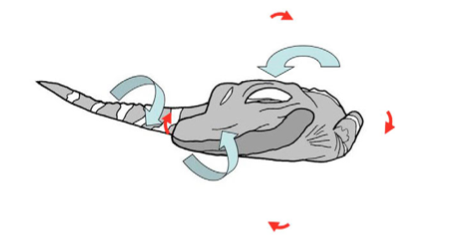Death Roll Behavior in Crocodilians
Biology 342 Fall 2006
Augustus Kilgore and Maya Jarrad
Mechanism
Once prey is caught that is too large for the crocodilian to swallow whole, it clamps its jaws onto a portion of flesh and initiates a death roll.

Diagram of movement and rotation direction. Red arrows are direction of spin, blue arrows are direction of movement. Image adapted from ref. 1
One comprehensive paper details the mechanism of twist feeding behavior (ref. 1). According to this paper, in order to initiate the death roll, the crocodilian bends itself into a c shape. The tail is vital for rotational movement, which cannot be conducted if it is held stationary (1). The crocodilian then rotates around its longitudinal axis, with very little side to side motion in the main part of the body. This enables the crocodilian to cut the flesh of its prey despite its deficient teeth (see Adaptation) (1). It is also specified in the procedure of the experiment of ref.1 that "several sharp tugs were given in order to induce rolling behavior", which suggests that the trigger for this behavior is resistance from prey. This resistance would not necessarily have to be active, as the prey could be dead, and the crocodilian merely encountering resistance by virtue of the fact that the piece of flesh it sought to eat was still attached. It was also found that the death roll is initiated from a stationary position; there is no momentum in motion before the prey (meat strip) is encountered.
Based on the model predictions of this the ref. 1 study, it was calculated that force exerted is exponentially proportional to body length, as is shown by the graph below, adapted from ref. 1

A different study also demonstrated that a species of amphibian which also displays torsional feeding behavior generated a force with twist feeding that was 133% of bite force (2). In the case of alligators, the force generated at the snout by the death roll was calculated to be 125N (1)